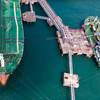Dry Bulk Fleet Growth Stable
Global dry bulk net fleet growth in 2018 was largely unchanged at 2.9% year on year due to reduced newbuilding deliveries and much reduced scrapping because of the improved freight market, said a report by Pacific Basin Shipping.
The provider of international dry bulk shipping through the operation of a fleet of vessels to carry diverse cargoes for many of the world's leading commodity groups said that, now close to zero, scrapping cannot reduce any further and will potentially increase due to the growing number of old vessels and the increasing burden of environmental regulation.
Growth in the dry bulk fleet was concentrated in the larger Panamax and Capesize segments in which capacity expanded 3.2% compared to 2.8% in 2017, it said.
The global fleet of Handysize and Supramax ships in which we specialise grew slower in 2018 at 2.4% compared to 3.6% in 2017.
The global dry bulk fleet continues to operate at below full speed, so there remains potential for effective tonnage supply to increase without adding new ships to the fleet, if fuel prices decrease.
Similarly, effective supply can tighten if fuel prices increase and ships slow down.
Meanwhile, it said that improved freight market conditions supported sale and purchase activity and increased vessel values.
Clarksons Research currently values a benchmark five year old Handysize bulk carrier (now defined as 37,000 dwt) and a benchmark 58,000 dwt Supramax both at US$17 million.
Handysize newbuilding prices have increased 8% since February 2018 to US$24 million











